Viola affinis Leconte
Common names:
Leconte's Violet, Sand Violet
Synonyms:
Viola affinis Leconte, Ann. Lyceum Nat. Hist. New York 2: 138. 1828 ["1826"]; Viola sororia Willd. subsp. affinis (Leconte) R.J.Little, Phytologia 80(4): 295. 1996; Viola sororia Willd. subsp. affinis (Leconte) R.J.Little, Phytologia 72(2): 78. 1992; Viola sororia Willd. var. affinis (Leconte) L.E.McKinney, Sida, Bot. Misc. 7: 39. 1992. TYPE: J. E. Leconte, plate number 24 of Leconte's unpublished watercolors, call number QK 495 V811 L496f, University of Notre Dame Libraries, Department of Special Collections, Section of Rare Books (LECTOTYPE (designated by Nir Gil-ad, Boissiera 53: 51. 1997): ND; isolectotype: K!).
Viola papilionacea Pursh, Fl. Amer. sept. 1: 173. 1813-1814
Viola nepetaefolia Greene, Pittonia 5: 92. 1902
Viola affinis Leconte var. subarctica J.Rousseau, Canad. J. Res. 28, sec. C: 245. 1952 ["1950"]
Viola affinis Leconte f. albiflora L.K.Henry, Castanea 18: 45. 1953
Description:
Acaulescent rosulate perennials from thick rhizome, ≤ 23 cm; foliage and peduncles green, glabrous except for scattered small subappressed hairs on upper surface of leaf blades; stipules free, irregularly glandular-fimbriate; leaves ascending, leaf blades undivided, largest ≤ 72 × 68 mm, in spring distinctly longer than broad and narrowly ovate-triangular, apex acute to narrowly rounded, in summer broadening to about as broad as long or broader and broadly ovate-triangular, apex acute to obtuse, base shallowly to deeply cordate, margins crenate but becoming more remote and shallow near apex, eciliate; chasmogamous peduncle held among the leaves, glabrous; chasmogamous flower ≤ 23 mm; calyx glabrous, eciliate; lowest sepals narrowly oblong-lanceolate to lanceolate, acute; auricles short and entire, not elongating in fruit; corolla blue to purple, throat white; spur short-globose; lateral petals densely bearded with filiform to slightly clavate hairs, spurred petal densely bearded; chasmogamous capsule green; cleistogamous flowers produced after chasmogamous, on prostrate peduncle much shorter than petioles and arching just before capsule dehiscence; cleistogamous capsule 6–10 mm, yellow-green drying tan with purple spots or blotches, often hirtellous; seeds 1.4–2.0 × 0.9–1.4 mm, light to medium yellow- or orange-brown, unspotted; 2n=54.
Similar species:
This species has the distinction of being the only Borealiamericanae violet to have frequently hirtellous cleistogamous capsules; the only other acaulescent eatern North American violet with hirtellous capsules is the often cultivated and escaped European V. odorata. In chasmogamous flower, with its narrowly ovate leaf blades longer than broad, this species can be distinguished from Viola cucullata by its short rounded auricles, lack of a conspicuously contrasting dark purple eyespot around the throat, long narrowly linear to weakly clavate hairs in the lateral petal beards, and densely bearded spurred petal; from V. langloisii by its strongly ascending to erect leaves, short rounded auricles, and densely bearded spurred petal; from V. missouriensis by leaves with the upper surface bearing scattered subappressed hairs, lanceolate to linear-lanceolate acuminate eciliate sepals, and densely bearded spurred petal; and from V. pratincola and V. retusa by its leaves with upper surface bearing scattered subappressed hairs, and short rounded auricles. In cleistogamous fruit, once its leaves have broadened substantially, it can be separated from V. communis, V. cucullata, V. langloisii, V. pratincola and V. retusa by the heavily spotted or blotched (and sometimes hirtellous) cleistogamous capsule on a prostrate peduncle; from Viola sororia [glabrous variant] and Viola sororia [hirsutuloides variant] by its narrow sharply acute sepals and yellow- to orange-brown seeds. It is distinct from V. missouriensis in its leaves with upper surfaces bearing scattered subappressed hairs, and lanceolate to linear-lanceolate acuminate eciliate sepals.
In chasmogamous flower this species can be distinguished from Viola cucullata by its short rounded auricles, lack of a conspicuously contrasting dark purple eyespot around the throat, long narrowly linear to weakly clavate hairs in the lateral petal beards, and densely bearded spurred petal, heavily purple-spotted and sometimes hirtellous cleistogamous capsule on a short prostrate peduncle, and yellow-orange to yellow-brown unspotted seeds. It can be separated from V. langloisii by its strongly ascending to erect leaves, short rounded auricles, densely bearded spurred petal, and heavily purple-spotted and sometimes hirtellous cleistogamous capsule on a short prostrate peduncle. It is distinct from V. missouriensis in leaves with the upper surface bearing scattered subappressed hairs, lanceolate to linear-lanceolate acuminate eciliate sepals, and densely bearded spurred petal. It differs from V. pratincola and V. retusa in its short rounded auricles, heavily purple-spotted and sometimes hirtellous cleistogamous capsule on a short prostrate peduncle, and yellow-orange to yellow-brown unspotted seeds.
Ecology:
Damp to saturated or inundated, often sandy soils bordering vernal pools, streams and rivers in mesic to wet forests, and on terraces in floodplains and swamp borders.
Distribution:
Widely distributed in e. North America but mostly absent from the Atlantic and Gulf Coastal Plains, ME to se. MN, south to n. GA and n. LA.
Rarity:
State listed in MO.
Phenology:
Chasmogamous flower Apr–May, chasmogamous fruit June, cleistogamous fruit June–September.
Affinities:
This species belongs to the Acaulescent Blue Violet lineage, sect. Nosphinium, subsect. Boreali-Americanae (W.Becker) Gil-ad,in the Affinis species group.
Hybrids:
Hybridizes with V. baxteri (Brainerd 1924, Haines et al. 2011), V. brittoniana (Dowell 1910, Brainerd 1924, House 1924), V. communis [or possibly V. "sororia glabrous" or V. "sororia hirsutulalike"] (House 1906b, 1924, Brainerd 1924), V. cucullata (Brainerd 1906b, 1924, House 1924, Gaiser and Moore 1966, Haines et al. 2011), V. emarginata sensu stricto (Brainerd 1924), V. fimbriatula (Dowell 1910, Brainerd 1924, House 1924, Haines et al. 2011), V. hirsutula (Brainerd 1906b, 1924, House 1906b, 1924, Dowell 1910), V. nephrophylla (Brainerd 1906b, 1924, House 1924, Haines et al. 2011), V. palmata var. triloba (Brainerd 1924), V. "palmata pseudo-stoneana" (Hastings 2018, Harvey Ballard pers. comm.), V. sagittata (Brainerd 1906b, 1910b, 1924, House 1924, Russell and Risser 1960, Russell 1965), V. septentrionalis (Brainerd 1904b, 1907a, 1924, House 1924), V. sororia sensu stricto (Brainerd 1904b, 1924, House 1924, Gaiser and Moore 1966, Haines et al. 2011), and V. subsinuata (Dowell 1910, Brainerd 1924, House 1924). Brainerd reported that these exhibit intermediate or recombinant characteristics of foliage, chasmogamous flowers, cleistogamous capsules and seeds (where these did not abort). Hybrids fail to reproduce by chasmogamous flowers, and the cleistogamous capsules either abort or produce a substantially reduced proportion of viable seeds.
Comments:
Brainerd (1921b), Brainerd Baird (1942), Fernald (1950), Henry (1953a), Alexander (1963), Russell (1965), Scoggan (1978), Strausbaugh and Core (1978), Swink and Wilhelm (1979), Ballard (1995, 2000), Gil-ad (1995, 1997, 1998), Haines et al. (2011), Voss and Reznicek (2012), and Weakley et al. (2012) maintained this species (although Haines et al. included V. latiuscula, and Ballard included V. langloisii, V. missouriensis, and V. rosacea); and Scoggan (1978) referred all Canadian material to var. subarctica Rousseau. Gleason and Cronquist (1991) synonymized it under V. sororia as a form with the spurred petal bearded. McKinney (1992) interpreted that Viola affinis Leconte and Viola nephrophylla Greene were synonymous, then made the (illegitimate) new combination Viola sororia Willd. var. affinis (Leconte) McKinney to accommodate the collective taxon. Little and McKinney (2015) later reinstated the two as separate species. Extensive field studies and abundant herbarium collections support recognition of the two as wholly distinct evolutionary species, and consultation of protologues and types confirm the traditional application of names as correct. Although Brainerd (1921) and others have included V. crenulata Greene and V. venustula Greene as synonyms of this species, some of the traits observed on type material indicate that these are better considered de novo hybrids with V. nephrophylla. This species is widely distributed in our region east of the Great Plains and western Midwest states but is commonly misidentified as the more commonly encountered V. cucullata or V. sororia. While it may form large linear populations in floodplains of larger river systems, it typically occurs as scattered solitary plants along smaller stream terraces and swamp borders, and is likely overlooked. Scattered records of V. affinis from northwestern Illinois and southern Wisconsin in the region of overlap with V. missouriensis have been confirmed. Contrary to Russell's (1965) statement that the two taxa intergrade with each other and with other taxa of the V. affinis complex, field and herbarium studies demonstrate that all members of the complex consistently maintain their many morphological distinctions, and each taxon simply "drops out" at the limits of their geographic range, presumably as ecological conditions become inhospitable to their persistence. This and other members of the Affinis species group are currently under study by Remington Burwell at Ohio University.
Literature Cited:
Alexander, E. J. 1963. Violaceae. In Gleason, H. A., The new Britton and Brown illustrated flora of the northeastern United States and adjacent Canada. Hafner Publishing Co., Inc., New York, NY. 552-567.
Ballard Jr., H. E. 1995 ["1994"]. Violets of Michigan. Michigan Botanist 33: 131-199.
Ballard Jr., H. E. 2000. Violaceae. In Rhoads, A. (ed.). Flora of Pennsylvania. University of Pennsylvania Press, Philadelphia, PA. 700-710.
Brainerd, E. 1904b. Hybridism in the genus Viola. Rhodora 6: 213-223, plate 58.
Brainerd, E. 1906b. Hybridism in the genus Viola,-III. Rhodora 8: 49-60, plates 66-70.
Brainerd, E. 1907a. The behavior of the seedlings of certain Viola hybrids. Science 25: 940-944.
Brainerd, E. 1910b. The evolution of new forms in Viola through hybridism. American Naturalist 44: 229-236.
Brainerd, E. 1921b. Violets of North America. Vermont Agricultural Experiment Station Bulletin 224: 1–172.
Brainerd, E. 1924. The natural violet hybrids of North America. Vermont Agricultural Experiment Station Bulletin 239: 1-205.
Brainerd Baird, V. 1942. Wild violets of North America. University of California Press, Berkeley, CA.
Dowell, P. 1910. The violets of Staten Island. Bull. Torr. Bot. Club 37: 163-179, pl. 11-18.
Fernald, M. L. 1950. Violaceae. In Gray’s Manual of Botany, 8th ed. American Book Company, New York, NY. 1022-1042.
Gaiser, L. O., and R. J. Moore. 1966. A survey of the vascular plants of Lambton County, Ontario. Plant Res. Inst. Can. Dept. Agric. Ottawa, Ont. 122 pp.
Gil-ad, N. L. 1995. Systematics and evolution of Viola L. subsection Boreali-Americanae (W. Becker) Brizicky. Ph.D. dissertation. University of Michigan, Ann Arbor, MI.
Gil-ad, N. L. 1997. Systematics of Viola subsection Boreali-Americanae. Boissiera 53: 1–130.
Gil-ad, N. L. 1998. The micromorphologies of seed coats and petal trichomes of the taxa of Viola subsect. Boreali-Americanae (Violaceae) and their utility in discerning orthospecies from hybrids. Brittonia 50: 91–121.
Gleason, H. A., and A. Cronquist. 1991. Violaceae. In Manual of vascular plants of northeastern United States and adjacent Canada, 2nd ed. New York Botanical Garden, Bronx, NY. 157-163.
Haines, A., E. Farnsworth, and G. Morrison. 2011. Violaceae. In Flora Novae Angliae. Yale University Press, New Haven, CT. 873-886.
Hastings, J. L. 2018. Systematic and ecological studies of the Viola subsinuata species complex. M.S. thesis. Ohio University, Athens, OH.
Henry, L. K. 1953a. The Violaceae in western Pennsylvania. Castanea 18(2): 37-59.
House, H. D. 1906b. The violets and violet hybrids of the District of Columbia and vicinity. Rhodora 8: 117-122, plates 71-72.
House, H. D. 1924. Annotated list of the ferns and flowering plants of New York state. Family 83 Violaceae. New York State Museum Bulletin 254: 499-512.
Little, R. J., and L. E. McKinney. 2015. Violaceae. In Flora of North America: Cucurbitaceae to Droseraceae, 106. Oxford University Press, New York, NY.
McKinney, L. E. 1992. A taxonomic revision of the acaulescent blue violets (Viola) of North America. Sida, Botanical Miscellany 7: 1–60.
Russell, N. H. 1965. Violets (Viola) of the central and eastern United States: An introductory survey. Sida 2: 1–113.
Russell, N. H., and A. C. Risser Jr. 1960. The hybrid nature of Viola emarginata. Brittonia 12: 298-305.
Scoggan, H. J. 1978. Violaceae. In Flora of Canada, Part 3–Dicotyledoneae (Saururaceae to Violaceae). National Museums of Canada. Ottawa, Canada. 1103-1115.
Strausbaugh, P. D., and E. L. Core. 1978. Violaceae. In Flora of West Virginia, 2nd ed. Seneca Books, Inc., Morgantown, WV. 644-658.
Swink, F., and G. Wilhelm. 1979. Violaceae. In Plants of the Chicago region, 2nd ed. revised and expanded. Morton Arboretum, Lisle, IL. 384, 801-810.
Voss, E. G., and A. A. Reznicek. 2012. Violaceae. In Field manual of Michigan flora. The University of Michigan Press, Ann Arbor, MI. 913-922.
Weakley, A. S., J. C. Ludwig, and J. F. Townsend. 2012. Violaceae. In Flora of Virginia. BRIT Press, Fort Worth, TX. 963-975.
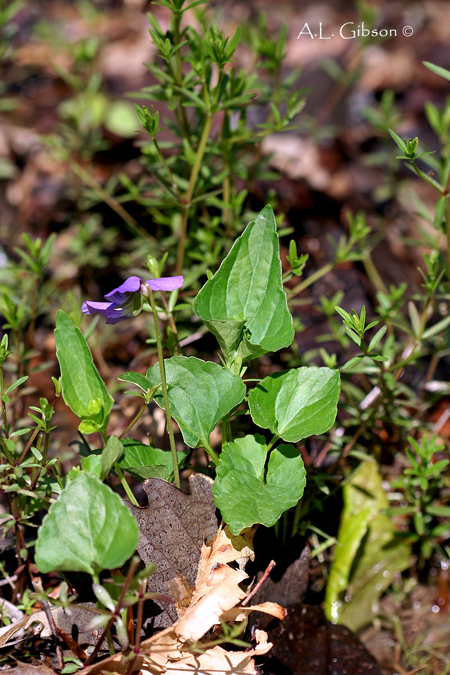
Chasmogamous flowering habit by Andrew Gibson, "Buckeye Botanist" website
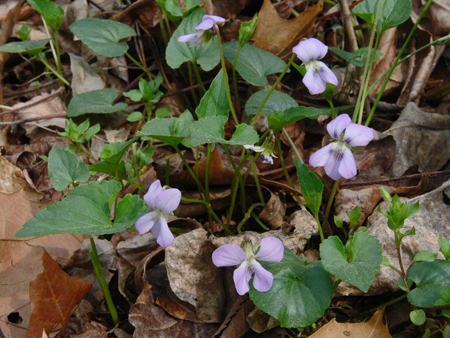
Chasmogamous flowering habit by Bruce Sorrie
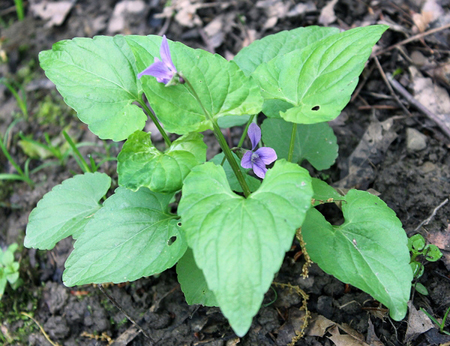
Leaves during chasmogamous flower by Jack Pierce, North Carolina State University Extension Gardener, under Creative Commons licence SA 2.0
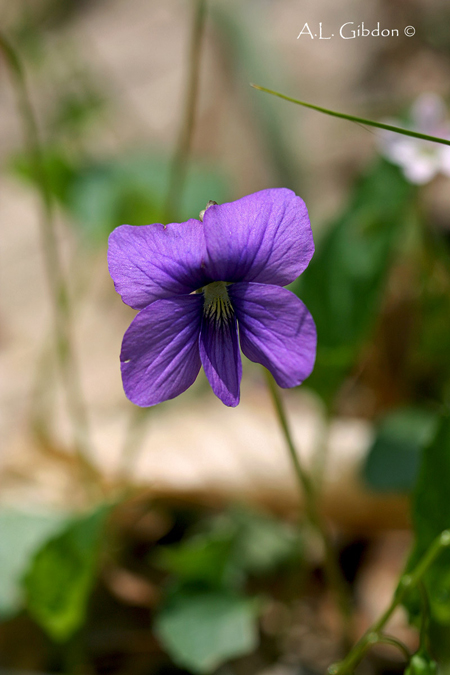
Chasmogamous flower front view by Andrew Gibson, "Buckeye Botanist" website
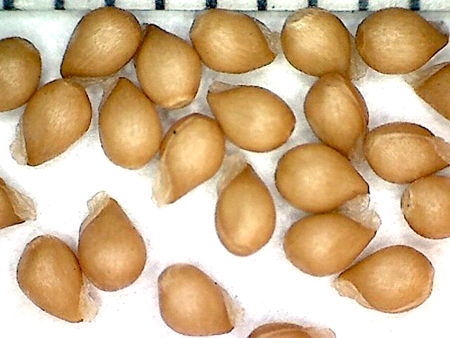
Seeds from herbarium specimen: Transplanted from NC, Cumberland Co., River Oaks Housing Development, H. Ballard 15-005F (BHO)

Seeds from herbarium specimen: Transplanted from NC, Biltmore, Eggleston donor, E. Brainerd 6 (NY)

Map of the Affinis species group by Harvey Ballard